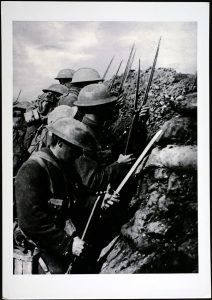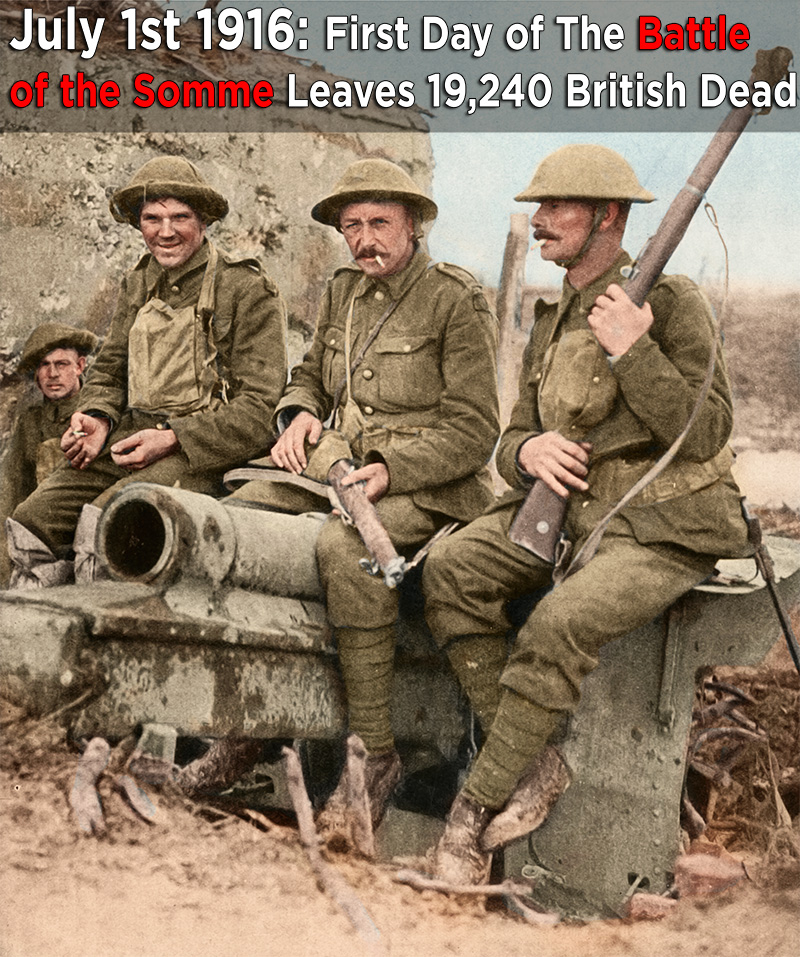First day on the Somme
Before the battle started, the British fired over 1,700,000 shells at the German soldiers. This initial pre-battle artillery bombardment lasted 8 days. Then on 1st July 1916, the Battle of the Somme commenced. Although nominally an Allied victory, this conflict is generally seen to epitomise the utter futility of trench warfare and resulted in massive losses for the British – not to mention every other force involved. By the end of the battle, in mid-November 1916, Britain had suffered 420,000 casualties, France 205,000 and Germany at least 680,000. In the first day of fighting alone, the most deadly of all, over 19,000 Allied troops died and 10-12,000 Germans. The gain from these months of bloodshed? The Allied forces advanced just eight kilometres or five miles.
51 Victoria Crosses were won by British soldiers. 31 were won by NCO’s and 20 by officers. Of these 51 medals, 17 were awarded posthumously – 10 to NCO’s and 7 to officers.
Researching YOUR Somme military ancestor.
From among these vast numbers, it is possible – and extremely moving – to find out more about your ancestor’s role in this tragic and historic battle. But where do you start when researching your ancestor’s service at the Somme? First, you need to identify what you already know.
If you know the number of the battalion he served in, you can go straight to the Unit War Diaries. If not, you need to track it down, to enable you to pinpoint the precise diary you need to learn where and when exactly his battalion was serving, in this official day-to-day account.
If you don’t know the number of the battalion he served in, you’ll find that many of the records you need to search are readily available online on Forces War Records from the UK, WWI War Diaries (France, Belgium, and Germany)
Tip: You may find the battalion number recorded in one source but not in another, so search widely.
-
Family photos
Examine family photos of your Tommy ancestor in uniform extremely carefully. Uniform details, such as cap badges, will help to identify his regiment. Letters and family memories will also provide useful clues to be followed up. If you need help with your photos please use the Forces War Records – ‘Document/Photo Expert Help’

-
Graves & memorials
It’s much easier to trace the service of a soldier who died in the war, than that of one who survived. If they died visit the impressive Commonwealth War Graves Commission CWGC records on Forces War Records – to find details such as name, service number, regiment, battalion, date of death, and memorial.
-
Service records
Unfortunately, approximately 70 per cent of First World War soldiers’ service records (TNA reference WO 363 and WO 364) were destroyed in WW2. But if your ancestor’s records have survived the fire, they will give extensive details, enabling you to identify him by factual information such as him. Search over 3.6million WW1 service Records on Forces War Records
-
Rolls of honour
81 volumes of Soldiers Died in the Great War, 1914-1919, were compiled in the 1920s by the War Office and include the battalion number and so much more. Within the Forces War Records database we have the IWGC/CWGC Registers Collection and Soldiers Who Died in the Great War 1914-1919, which includes two lists of those who died during the Great War. One volume, packed with minute typescript, gave the basic details of nearly 42,000 officer casualties. It required an additional eighty volumes to list all the ‘other ranks’ and each of the original volumes represented one or more regiments, corps or other units of the British Army. You can also find a vast collection of independent rolls of Honour within the Forces War Records Historic Documents Archive.
-
Medal Index Cards
The medal index card collection (TNA references: medal index cards WO 372, and medal rolls WO 329) includes details for about 5 million British service personnel – officers and men – who served in the war. Sometimes the rolls provide the battalion number, so it is worth checking the cards and the rolls on Forces War Records.
-
Gallantry awards
In addition to the campaign medals (the 1914 Star, the 1914-15 Star, the British War Medal and the Victory Medal) the exceptional bravery of some people was recognised by gallantry awards such as the Victoria Cross and Military Medal. Search for your ancestor in the Forces War Records – Gazetted Awards and Mentions in Despatches collection.
-
Silver War Badge
Many injured soldiers returned to the Front line, but those discharged because of their wounds were awarded a Silver War Badge (TNA reference WO 329). Search for your ancestor in the Forces War Records – Silver War Badge List 1914-1918 collection.
-
Browsing nominal rolls
In addition to the medal rolls, there are also nominal rolls – lists naming those who served by regiment for the duration of the war – and some of the entries include the battalion number too.
-
Soldiers’ Register of Effects
The registers record the money that the British Government paid to the next of kin of servicemen who died in the First World War. The inclusion of the next of kin makes these records particularly valuable to family historians, as this information can help researchers take a family back another generation or distinguish between soldiers with the same name. Early records also list a soldier’s trade before enlistment. Search over 880,000 records within the UK, British Army Registers of Soldiers’ Effects, 1901-1929
-
Soldiers’ wills
Look for soldiers’ wills at https://www.gov.uk/probate-search; soldierswills.nationalarchives.ie/search/sw/home.jsp and scotlandspeople.gov.uk.
-
Casualty lists
At the start of the First World War, it was decided to publish casualty list for soldiers who were reported killed, died of wounds or accident, been declared as missing, wounded or admitted to hospital with shell-shock. The ‘Daily War Office Casualty Lists’ were first published on 1st September 1914 and printed within various newspapers such as The Times, Daily Telegraph, The Irish Times and The Scotsman until August 1917. In August, it was decided that newspapers would no longer be able to print the casualty list in full due to the shortage of paper. Instead, the Daily Casualty List were published as the ‘Weekly Casualty List’ by His Majesty’s Stationery Office. Forces War Records has now transcribed all the records published within The Daily Telegraph Newspaper and we are very proud to be working with the National Library of Scotland to transcribe their original collection of the ‘Weekly Casualty List by His Majesty’s Stationery Office’. These records are of enormous value to researchers, for in many cases the information that a man appeared in a list will not be available elsewhere. Search this collection HERE.
-
Royal Flying Corps
The Royal Flying Corps (forerunner of the RAF) came to the fore, taking its most major role so far in the war, at the Battle of the Somme 1916. The nominal rolls, Operational Record Books and the Casualty Lists (found at TNA in AIR 1) will help you trace your RFC ancestors’ service. Squadrons 1, 2, 3, 4, 6, 9, 10, 41 and 70 served at the Somme in some capacity. Forces War Records has the RAF Formations List 1918 collection, which is in effect a ‘muster roll’ of the entire RAF on its inception on April 1st 1918.
It is a complete list of everyone recorded as being employed in any role within the new RAF and hence is of critical importance, very few types of service will ever have had such a complete listing at any time, the database may well be unique in this respect.
-
Order of Battle
Hopefully one of the sources above will have helped you to find your ancestor’s regiment and his battalion. Now look through the Order of Battle for the Somme you will see whether his battalion served there in 1916 – see HERE
Forces War Records also has a unique feature that will track the troop movements of your WW1 Army ancestor with an interactive ‘moving’ audio-visual map. Here’s how it works… If you know the battalion your army ancestor was in, you can locate where he was based, and track the unit’s manoeuvres, step by step, as well as read or listen to what happened at each location. Learn what happened where, and when, with this fascinating exclusive feature from Forces War Records! (SEE MORE)
-
Unit War Diaries
The Unit War Diaries are the official military accounts that give day-by-day details of the action, locality, conditions, etc of the battalion. Details are brief, but they make valuable reading, revealing both the monotony and horror of life on the Western Front. They are unlikely to mention your ancestor by name, unless they were an officer. Forces War Records has the UK, WWI War Diaries (France, Belgium, and Germany) available to search
-
Trench maps
Use the place names you find in the diaries and locate them on trench maps. Looking at a map will help you make so much more sense of the diaries. Find trench maps free online at the National Library of Scotland HERE (TNA reference WO 297 for the Western Front).
-
Regimental histories
Background reading is extremely useful for learning about the battle, the key attacks, the strategies and disasters. Look out particularly for regimental histories and accounts written, in the years after the war, by people who were actually there. You will find a great many regimental histories, first hand accounts, newspapers, historical documents and images within the Forces War Records ‘Historic Library’ which you can search by keyword or phrase.


